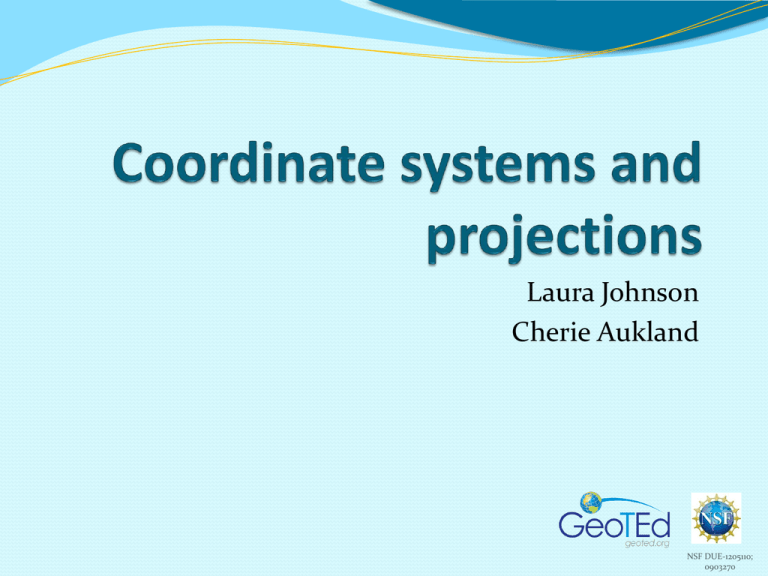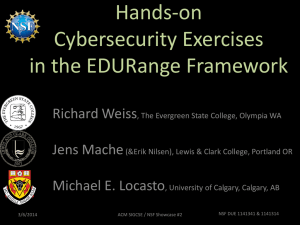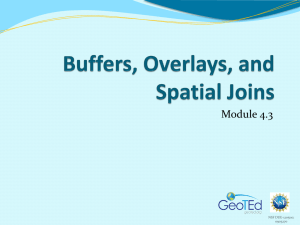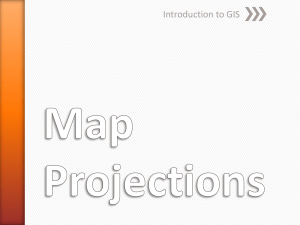4.1 Projections
advertisement

Laura Johnson Cherie Aukland NSF DUE-1205110; 0903270 GeoTEd Partners Module name and number NSF DUE-1205110; 0903270 Module Outline Methods of determining location Spatial Reference Coordinate system Datum Projection Module name and number NSF DUE-1205110; 0903270 What Is Our Location? The question: Where am I on the earth? Answers: Blacksburg, VA zip code 24060 mile marker 118, I-81 Worsham field: Latitude: 32.21997, Longitude: -80.41873 NSF DUE-1205110; 0903270 Where am I? All of the previous answered the question, but which one will help me the most? All are forms of georeferencing, or communicating location on the earth’s surface NSF DUE-1205110; 0903270 Spatial Reference A way to communicate location that has up to three components: Coordinate system (X, Y) Datum (accounts for shape of the earth) Projection (minimizes 3D -> 2D distortion in some capacity) NSF DUE-1205110; 0903270 Coordinate Systems Measure X, Y from an origin point Origin and units vary based on the coordinate system Common systems: UTM, Universal Transverse Mercator Public Land Survey System (PLSS) coordinates Latitude and Longitude (WGS84) NSF DUE-1205110; 0903270 Public Survey Public Land Survey System (PLSS) used to survey most of the Western US and Western Canada Used to determine ownership Doesn’t account for the curvature of the earth Divides areas into townships, ranges, sections, and quarter sections Coordinate systems typically in meters or feet NSF DUE-1205110; 0903270 Latitude and Longitude Geographic coordinates Starts at the equator and the prime meridian Units of measurement are degrees, minutes, and seconds 60 minutes in a degree 60 seconds in a minute NSF DUE-1205110; 0903270 Spatial Reference Coordinate system Datum Projection NSF DUE-1205110; 0903270 What is a datum? Model of the shape of the earth’s surface The earth is not a perfect sphere Spheroid = equation attempting to model the actual shape of the earth’s surface Spheroid Earth’s Surface Origins NSF DUE-1205110; 0903270 What is a Datum? Datums define: shape of the earth location of latitude and longitude of origin NSF DUE-1205110; 0903270 Datums Earth’s Surface Datum NSF DUE-1205110; 0903270 Common Datums NAD27 NAD83 WGS84 What do you think will happen if you use the wrong datum? NSF DUE-1205110; 0903270 Spatial Reference Coordinate system Datum Projection NSF DUE-1205110; 0903270 Projections Take a 3-D world and make it 2-D NSF DUE-1205110; 0903270 Projections Important to know what projection you are using to minimize measurement and display errors Projections are a way of taking a 3-D object (earth) and making a 2-D object (map) NSF DUE-1205110; 0903270 Errors Projections usually try to hold one of the following constant: Conformal (keep shapes the same) Equal area (keep areas the same) Equidistant (keep distances the same) No projection can achieve all three Some use a compromise of each NSF DUE-1205110; 0903270 Projections Three ways of projecting Cylindrical Earth Conic Planar Earth Earth Wherever the projection surface “touches” the earth, there will be the least amount of distortion. NSF DUE-1205110; 0903270 Common Spatial References Albers Equal-area Projection, good for large areas where area measures are important Lambert conformal conic Also good for large areas where visualization is important NSF DUE-1205110; 0903270 Common Spatial References Universal Transverse Mercator (UTM) One of the most common coordinate systems and projections Measures in meters Has “Zones” Great for local areas Geographic or Cylindrical Equidistant No projection or datum Just has coordinates assigned Directions true, All else distorted NSF DUE-1205110; 0903270 Common Spatial References State Plane system Varies by state Specifies projection, coordinates, and datum Good for state-wide analyses Some states have multiple coordinate systems For example, Texas Can use UTM, Lambert, Albers, or own projection Good for surveying NSF DUE-1205110; 0903270 Questions? Module name and number NSF DUE-1205110; 0903270







